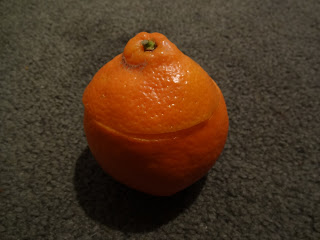 |
| This candle was leaning over too far, so I propped it up with a folded piece of paper. |
 |
| Minneola tangelos also work well. |
1. Cut into the peel on the orange. Try not to cut into the juicy flesh, because the juice could make the peel wet and cause it to have trouble lighting. Cut all the way around the orange. You might want to have a few extra oranges in case something goes wrong.
2. Remove the peel on the side opposite the stem. The wick will be on the stem side, so you need to keep that part intact. The rest can be thrown away, unless you want to stack the two halves, in which case you'll need to save both halves of the peel.
 3. Carefully remove the segments of the orange. There will be a foamy strip in the center of the orange, and it needs to be attached to the peel. This strip is the wick. Make sure to keep it attached to the peel, and only remove the orange segments. Try not to get any juice on the foamy wick, because if you do it won't light. Once you get the segments out, the peel should look like a bowl with a wick sticking up out of it.
3. Carefully remove the segments of the orange. There will be a foamy strip in the center of the orange, and it needs to be attached to the peel. This strip is the wick. Make sure to keep it attached to the peel, and only remove the orange segments. Try not to get any juice on the foamy wick, because if you do it won't light. Once you get the segments out, the peel should look like a bowl with a wick sticking up out of it.4. Let the orange peel bowl dry overnight so it will light more easily. You may want to stuff the bowl with paper towels to help it hold its shape, because otherwise it will probably distort itself as it dries. Keep in mind that drying overnight does not mean you can get the wick wet, because excessive moisture causes the wick to shrink and lose its necessary sponge-like properties.
 5. Put the peel on a flame-resistant plate, and then fill it with some oil that has a scent that you like. I use olive oil, but coconut oil or peanut oil should work just as well. If you don't have anything else, you could just use some canola oil, but I don't see the point and it probably isn't a good thing to inhale. Once you add the oil, wait a few seconds for the oil to soak into the wick.
5. Put the peel on a flame-resistant plate, and then fill it with some oil that has a scent that you like. I use olive oil, but coconut oil or peanut oil should work just as well. If you don't have anything else, you could just use some canola oil, but I don't see the point and it probably isn't a good thing to inhale. Once you add the oil, wait a few seconds for the oil to soak into the wick.6. Light the wick. If you did it right, the candle should flare up very brightly for a couple of seconds, and then dim down to the brightness of an ordinary candle.
7. Enjoy your glowing orange candle!
Thanks to my sister for finding the basic technique for making an orange candle. I'm not sure where she got it from, but it's good so I made some modifications and posted it here.
As with all candles, remember that this is fire, so you should make sure to exercise appropriate safety precautions. Also keep in mind that when the candle runs out of oil, it might begin to burn the peel instead of the wick, and if anything flammable is nearby, the fire could potentially spread. Usually, for me, it goes out by itself once the oil is gone, and even if it doesn't go out right away, the plate should prevent any fire from spreading. Nevertheless, if you wanted you could moisten the inside of the candle (but not the wick) just before adding the oil, so that when the wick runs out, everything else will be too wet to burn. I also suggest that you keep an eye on your first couple of candles, to make sure nothing goes wrong.
Lastly, is this a cheap alternative to candles? I checked a few prices and decided that if you use olive oil it's approximately the same price, maybe even slightly more expensive. So it isn't cheaper. But hey, what could be cooler than a glowing orange?
...don't answer that.
New posts every month - subscribe for free!
Is there any oil leak? and is the flame really that bright?
ReplyDeleteOrange peel can hold liquid surprisingly well. If the peel does not have any holes in it, the oil will not leak. And yes, the flame is at least as bright as an ordinary candle flame.
Delete